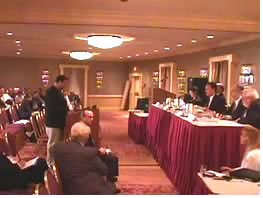
The U.S. Department of Energy (DOE) called for a review of its Office of Energy Efficiency and Renewable Energy (EERE) in accordance with President Bush's National Energy Policy released May 17. EERE subsequently called for public comment on the value of its programs, the deadline for which is June 29. Despite the short notice, the AIA, which has a longstanding relationship with the DOE regarding energy-efficiency research, submitted statements of strong support both in writing and at the open forum in Washington, D.C., June 26.
Mella is spokesperson
The AIA had the third speaking slot (following Daimler-Chrysler) at the
June 26 hearing. Greg Mella, AIA, a member of the AIA Committee on the
Environment (COTE) who works for the SmithGroup, highlighted the most
recent collaboration between the DOE and the AIA, the Top Ten Green Projects
initiative. Effectively used to interest the media in building energy
efficiency, the DOE/AIA project selected 10 projects that exemplify resource
efficiency and environmental sensitivity. Among the projects selected
was the SmithGroup's design for the Chesapeake Bay Foundation Headquarters,
the only recipient to date of the Leadership in Energy and Environmental
Design (LEED) Platinum rating. LEED is a green building rating system
created by the U.S. Green Building Council.
 Coinciding
with Earth Day 2001, the naming of the top 10 projects and description
of their resource—conserving aspects generated stories in newspapers
and magazines across the country, including the Baltimore Sun, Denver
Post, San Francisco Chronicle, and Washington Business Review. The message
for the public is that winning projects make a positive contribution to
their communities, improve comfort for building occupants, and reduce
environmental impact. Strategies include reuse of existing structures,
connection to transit systems, low-impact site development, energy and
water conservation, use of "green" construction materials, and
improvement of indoor air quality.
Coinciding
with Earth Day 2001, the naming of the top 10 projects and description
of their resource—conserving aspects generated stories in newspapers
and magazines across the country, including the Baltimore Sun, Denver
Post, San Francisco Chronicle, and Washington Business Review. The message
for the public is that winning projects make a positive contribution to
their communities, improve comfort for building occupants, and reduce
environmental impact. Strategies include reuse of existing structures,
connection to transit systems, low-impact site development, energy and
water conservation, use of "green" construction materials, and
improvement of indoor air quality.
"We applaud DOE for holding these hearings, for working with the private sector to advance energy awareness, and for stressing our profession's commitment to improving the efficiency and economy of our built environment," Mella told the DOE panel. Conserving energy through thoughtful design will bring tremendous savings in resources, he said.
Continuing collaboration
Other programs the AIA and DOE continue to work on include the Sun Wall
and the Solar Decathlon.
The Sun Wall is a design collaboration between architect Solomon Cordwell
Buenz & Associates, Chicago, and Ove Arup & Partners, New York
City, that proposes to turn a parking lot on the south side of the DOE
headquarters into a welcoming plaza shaded in part with a vast array of
solar panels. Construction of the project, estimated at $10 million, is
not funded. The Solar Decathlon is a competition among 11 universities
to design solar-powered houses of 500 to 800 square feet that the teams
of architecture, engineering, accounting, and communications students
will construct on the Capitol Mall in the fall of 2002. Design quality
is one of the 10 judging criteria. To illustrate the importance of aesthetics
in public acceptance of solar design, the design category carries twice
as many possible points as each of the other nine criteria.
 The
AIA and DOE are also working together on the DOE's High Performance Commercial
Buildings Roadmap, which strives to elevate building performance design
standards through a whole-building design approach.
The
AIA and DOE are also working together on the DOE's High Performance Commercial
Buildings Roadmap, which strives to elevate building performance design
standards through a whole-building design approach.
EERE tools for architects
The EERE funds research, development, demonstration and deployment of
affordable, advanced energy technologies and practices in five areas:
buildings, industry, transportation, power generation and delivery, and
federal facilities.
Tools developed by DOE for energy and environmentally conscious architects
and builders include the Energy Star and Federal Energy Management Program
(FEMP) rating programs. Energy Star rates buildings and a wide variety
of equipment, products, and appliances as to energy efficiency. FEMP targets
government buildings.
The AIA considers energy efficiency to be a primary policy goal because of the shift in public attitude in recent years toward "building green." Delegates to the AIA convention in Denver in May approved a resolution written by the COTE supporting energy efficiency and the search for alternative energy solutions.
"The strides that our country has taken toward these goals are in no small part the work of DOE," states a COTE position paper supporting EERE work. "These achievements have resulted from years of study and development of alternative technologies, new construction materials, and new approaches to development."
The DOE is accepting written comments until 5:00 p.m. EDT, June 29. All written comments will be included in the proceedings of the seven public meetings.
Copyright 2001 The American Institute of Architects. All rights reserved.
![]()
|
For more information about the public meetings, visit the EERE site. To review a copy of the National Energy Policy, visit the DOE site. Read more about the Solar Decathlon project. Greg Malla, AIA, expresses AIA support for DOE work on energy efficiency and resource conservation (left and below.) Photos by Phil Simon |
|